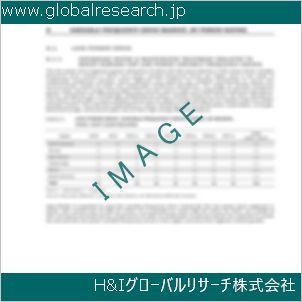1 報告の範囲
1.1 市場概要
1.2 対象期間
1.3 研究目的
1.4 市場調査手法
1.5 研究プロセスとデータソース
1.6 経済指標
1.7 対象通貨
1.8 市場推計の留意点
2 執行要約
2.1 世界市場の概要
2.1.1 ウェアラブル機器の年間販売動向(2020年~2031年)
2.1.2 地域別ウェアラブル用メカニズムの現在の状況と将来予測(2020年、2024年、2031年)
2.1.3 ウェアラブル向けメカニズムの地域別(国/地域)現在の動向と将来予測(2020年、2024年、2031年)
2.2 ウェアラブル用メカニクスセグメント別分析(タイプ別)
2.2.1 ポリカーボネート
2.2.2 ポリイミド
2.2.3 ポリプロピレン
2.2.4 アルミニウム合金
2.3 ウェアラブル販売のメカニズム(タイプ別)
2.3.1 ウェアラブル販売のグローバル市場シェア(種類別)(2020-2025)
2.3.2 ウェアラブル製品の種類別グローバル市場規模と売上高シェア(2020-2025)
2.3.3 ウェアラブル販売価格のグローバルメカニズム(2020-2025)
2.4 ウェアラブルセグメントのメカニズム(用途別)
2.4.1 スマートウォッチ
2.4.2 スマートブレスレット
2.4.3 その他
2.5 ウェアラブル販売のメカニズム(アプリケーション別)
2.5.1 アプリケーション別ウェアラブル販売市場シェア(2020-2025)
2.5.2 アプリケーション別ウェアラブル売上高と市場シェアのグローバル動向(2020-2025)
2.5.3 アプリケーション別ウェアラブル販売価格のグローバル動向(2020-2025)
3 グローバル企業別
3.1 ウェアラブル市場における企業別詳細データ
3.1.1 ウェアラブル用メカニクス グローバル年間売上高(企業別)(2020-2025)
3.1.2 ウェアラブルの売上市場シェアのグローバル動向(企業別)(2020-2025)
3.2 ウェアラブルの年間売上高のグローバル動向(企業別)(2020-2025)
3.2.1 ウェアラブルの売上高のグローバル動向(企業別)(2020-2025)
3.2.2 ウェアラブル市場における企業別売上高市場シェア(2020-2025)
3.3 ウェアラブル用メカニクス グローバル販売価格(企業別)
3.4 主要メーカーのウェアラブル製品生産地域分布、販売地域、製品タイプ
3.4.1 主要メーカーのウェアラブル製品拠点分布動向
3.4.2 主要プレイヤーのウェアラブル製品提供動向
3.5 市場集中率分析
3.5.1 競争環境分析
3.5.2 集中率(CR3、CR5、CR10)および(2023-2025)
3.6 新製品と潜在的な新規参入者
3.7 市場M&A活動と戦略
4 地域別ウェアラブル機械の世界歴史的レビュー
4.1 地域別ウェアラブル用機械市場規模の過去動向(2020-2025)
4.1.1 地域別ウェアラブル用機械工学の年間売上高(2020-2025)
4.1.2 地域別ウェアラブル機械の年間売上高(2020-2025)
4.2 ウェアラブル用メカニクス市場規模(地域別)(2020-2025)
4.2.1 ウェアラブルの年間販売額(地域別)のグローバル動向(2020-2025)
4.2.2 地域別ウェアラブル年間売上高のグローバル動向(2020-2025)
4.3 アメリカズにおけるウェアラブル販売成長の動向
4.4 アジア太平洋地域におけるウェアラブル市場規模の成長動向
4.5 ヨーロッパのウェアラブル市場における売上高成長メカニズム
4.6 中東・アフリカ地域におけるウェアラブル製品の販売成長動向
5 アメリカ
5.1 アメリカズ ウェアラブル販売のメカニズム(国別)
5.1.1 アメリカズにおけるウェアラブル販売の動向(国別)(2020-2025)
5.1.2 アメリカズにおけるウェアラブル売上高の地域別動向(2020-2025)
5.2 アメリカズにおけるウェアラブル販売の動向(タイプ別)(2020-2025)
5.3 アメリカズにおけるウェアラブル販売の動向(用途別)(2020-2025)
5.4 アメリカ合衆国
5.5 カナダ
5.6 メキシコ
5.7 ブラジル
6 アジア太平洋
6.1 APAC地域別ウェアラブル販売のメカニズム
6.1.1 APAC地域別ウェアラブル販売動向(2020-2025)
6.1.2 APAC地域別ウェアラブル売上動向(2020-2025)
6.2 アジア太平洋地域におけるウェアラブル販売の動向(タイプ別)(2020-2025)
6.3 APAC地域別ウェアラブル販売動向(2020-2025)
6.4 中国
6.5 日本
6.6 韓国
6.7 東南アジア
6.8 インド
6.9 オーストラリア
6.10 中国・台湾
7 ヨーロッパ
7.1 ヨーロッパのウェアラブル市場動向(国別)
7.1.1 欧州のウェアラブル市場動向(国別)(2020-2025)
7.1.2 ヨーロッパ ウェアラブル機械装置の売上高(国別)(2020-2025)
7.2 ヨーロッパ ウェアラブル機械装置の売上高(タイプ別)(2020-2025)
7.3 欧州のウェアラブル市場動向(用途別)(2020-2025)
7.4 ドイツ
7.5 フランス
7.6 イギリス
7.7 イタリア
7.8 ロシア
8 中東・アフリカ
8.1 中東・アフリカ ウェアラブル機械装置の市場動向(国別)
8.1.1 中東・アフリカ ウェアラブル機械装置の売上高(国別)(2020-2025)
8.1.2 中東・アフリカ地域におけるウェアラブル機械の売上高(国別)(2020-2025)
8.2 中東・アフリカ地域におけるウェアラブル機器の販売動向(タイプ別)(2020-2025)
8.3 中東・アフリカ地域におけるウェアラブル機械装置の売上高(2020-2025年)
8.4 エジプト
8.5 南アフリカ
8.6 イスラエル
8.7 トルコ
8.8 GCC諸国
9 市場動向、課題、およびトレンド
9.1 市場ドライバーと成長機会
9.2 市場課題とリスク
9.3 業界の動向
10 製造コスト構造分析
10.1 原材料とサプライヤー
10.2 ウェアラブル向け機械部品の製造コスト構造分析
10.3 ウェアラブル用機械部品の製造プロセス分析
10.4 ウェアラブル用機械の産業チェーン構造
11 マーケティング、販売代理店および顧客
11.1 販売チャネル
11.1.1 直接チャネル
11.1.2 間接チャネル
11.2 ウェアラブル用機械工学の卸売業者
11.3 ウェアラブル顧客の仕組み
12 地域別ウェアラブルのメカニズムに関する世界予測レビュー
12.1 地域別ウェアラブル市場規模予測のグローバルメカニズム
12.1.1 地域別ウェアラブルメカニズム予測(2026-2031)
12.1.2 地域別ウェアラブル用メカニズムの年間売上高予測(2026-2031)
12.2 アメリカ地域別予測(2026-2031)
12.3 アジア太平洋地域別予測(2026-2031)
12.4 欧州地域別予測(2026-2031)
12.5 中東・アフリカ地域別予測(2026-2031年)
12.6 グローバル ウェアラブル市場予測(タイプ別)(2026-2031)
12.7 ウェアラブル市場の世界的動向:用途別予測(2026-2031)
13 主要企業分析
13.1 Fitbit
13.1.1 Fitbit企業情報
13.1.2 Fitbitのウェアラブル製品ポートフォリオと仕様
13.1.3 Fitbitのウェアラブル製品販売、売上高、価格、粗利益(2020-2025年)
13.1.4 Fitbitの主要事業概要
13.1.5 Fitbitの最新動向
13.2 サムスン
13.2.1 サムスン企業情報
13.2.2 サムスンのウェアラブル製品ポートフォリオと仕様の動向
13.2.3 サムスンのウェアラブル製品の販売、売上高、価格、粗利益率の動向(2020-2025)
13.2.4 サムスンの主要事業概要
13.2.5 サンスン最新動向
13.3 FIHモバイル株式会社
13.3.1 FIHモバイルリミテッドの会社情報
13.3.2 FIHモバイルリミテッドのウェアラブル製品ポートフォリオと仕様の動向
13.3.3 FIHモバイルリミテッドのウェアラブル製品の販売、売上高、価格、粗利益率の動向(2020-2025)
13.3.4 FIHモバイルリミテッド 主な事業概要
13.3.5 FIH Mobile Limited 最新動向
13.4 フォックスコン・テクノロジー・グループ
13.4.1 Foxconn Technology Group 会社概要
13.4.2 Foxconn Technology Group ウェアラブル製品ポートフォリオと仕様の動向
13.4.3 Foxconn Technology Group ウェアラブル製品の売上、収益、価格、粗利益率の動向(2020-2025)
13.4.4 Foxconn Technology Group 主な事業概要
13.4.5 フォックスコン・テクノロジー・グループ 最新動向
13.5 Compal Electronics
13.5.1 Compal Electronics 会社概要
13.5.2 Compal Electronics ウェアラブル製品ポートフォリオと仕様の動向
13.5.3 Compal Electronics ウェアラブル製品の販売、売上高、価格、粗利益率(2020-2025)
13.5.4 Compal Electronics 主な事業概要
13.5.5 Compal Electronicsの最新動向
13.6 BOE
13.6.1 BOE 会社情報
13.6.2 BOE ウェアラブル製品ポートフォリオと仕様の動向
13.6.3 BOEのウェアラブル製品の販売、売上高、価格、粗利益率の動向(2020-2025)
13.6.4 BOE 主な事業概要
13.6.5 BOEの最新動向
13.7 Byd Electronics
13.7.1 Byd Electronics 会社概要
13.7.2 BYDエレクトロニクス ウェアラブル製品ポートフォリオと仕様の動向
13.7.3 Byd Electronics ウェアラブル製品の販売、売上高、価格、粗利益率(2020-2025)
13.7.4 BYDエレクトロニクス 主な事業概要
13.7.5 Byd Electronicsの最新動向
13.8 Tongda
13.8.1 Tongda 会社情報
13.8.2 Tongdaのウェアラブル製品ポートフォリオと仕様
13.8.3 Tongdaのウェアラブル製品販売、売上高、価格、粗利益率(2020-2025)
13.8.4 Tongdaの主要事業概要
13.8.5 Tongdaの最新動向
13.9 エバーウィン・プレシジョン
13.9.1 EVERWN PRECISION 会社概要
13.9.2 EVERWN PRECISION ウェアラブル製品ポートフォリオと仕様
13.9.3 EVERWN PRECISION ウェアラブル製品向け機械部品の売上高、収益、価格、粗利益率(2020-2025)
13.9.4 EVERWN PRECISION 主な事業概要
13.9.5 EVERWN PRECISION 最新動向
13.10 CCTC
13.10.1 CCTC 会社情報
13.10.2 CCTC ウェアラブル製品ポートフォリオと仕様の動向
13.10.3 CCTC ウェアラブル製品の売上、収益、価格、粗利益率の動向(2020-2025)
13.10.4 CCTC 主な事業概要
13.10.5 CCTCの最新動向
13.11 キャッチャー
13.11.1 キャッチャー企業情報
13.11.2 キャッチャーのウェアラブル製品ポートフォリオと仕様に関するメカニズム
13.11.3 キャッチャーのウェアラブル製品販売、売上高、価格、粗利益率(2020-2025)
13.11.4 キャッチャーの主要事業概要
13.11.5 キャッチャーの最新動向
13.12 AACテクノロジーズ
13.12.1 AAC Technologies 会社情報
13.12.2 AAC Technologiesのウェアラブル製品ポートフォリオと仕様のメカニズム
13.12.3 AAC Technologies ウェアラブル製品の販売、売上高、価格、粗利益率(2020-2025)
13.12.4 AAC Technologies 主な事業概要
13.12.5 AAC Technologiesの最新動向
14 研究結果と結論
13.12.2 AAC Technologies ウェアラブル製品ポートフォリオのメカニズム
1 Scope of the Report
1.1 Market Introduction
1.2 Years Considered
1.3 Research Objectives
1.4 Market Research Methodology
1.5 Research Process and Data Source
1.6 Economic Indicators
1.7 Currency Considered
1.8 Market Estimation Caveats
2 Executive Summary
2.1 World Market Overview
2.1.1 Global Mechanics for Wearable Annual Sales 2020-2031
2.1.2 World Current & Future Analysis for Mechanics for Wearable by Geographic Region, 2020, 2024 & 2031
2.1.3 World Current & Future Analysis for Mechanics for Wearable by Country/Region, 2020, 2024 & 2031
2.2 Mechanics for Wearable Segment by Type
2.2.1 Polycarbonate
2.2.2 Polyimide
2.2.3 Polypropylene
2.2.4 Aluminum Alloy
2.3 Mechanics for Wearable Sales by Type
2.3.1 Global Mechanics for Wearable Sales Market Share by Type (2020-2025)
2.3.2 Global Mechanics for Wearable Revenue and Market Share by Type (2020-2025)
2.3.3 Global Mechanics for Wearable Sale Price by Type (2020-2025)
2.4 Mechanics for Wearable Segment by Application
2.4.1 Smart Watch
2.4.2 Smart Bracelet
2.4.3 Other
2.5 Mechanics for Wearable Sales by Application
2.5.1 Global Mechanics for Wearable Sale Market Share by Application (2020-2025)
2.5.2 Global Mechanics for Wearable Revenue and Market Share by Application (2020-2025)
2.5.3 Global Mechanics for Wearable Sale Price by Application (2020-2025)
3 Global by Company
3.1 Global Mechanics for Wearable Breakdown Data by Company
3.1.1 Global Mechanics for Wearable Annual Sales by Company (2020-2025)
3.1.2 Global Mechanics for Wearable Sales Market Share by Company (2020-2025)
3.2 Global Mechanics for Wearable Annual Revenue by Company (2020-2025)
3.2.1 Global Mechanics for Wearable Revenue by Company (2020-2025)
3.2.2 Global Mechanics for Wearable Revenue Market Share by Company (2020-2025)
3.3 Global Mechanics for Wearable Sale Price by Company
3.4 Key Manufacturers Mechanics for Wearable Producing Area Distribution, Sales Area, Product Type
3.4.1 Key Manufacturers Mechanics for Wearable Product Location Distribution
3.4.2 Players Mechanics for Wearable Products Offered
3.5 Market Concentration Rate Analysis
3.5.1 Competition Landscape Analysis
3.5.2 Concentration Ratio (CR3, CR5 and CR10) & (2023-2025)
3.6 New Products and Potential Entrants
3.7 Market M&A Activity & Strategy
4 World Historic Review for Mechanics for Wearable by Geographic Region
4.1 World Historic Mechanics for Wearable Market Size by Geographic Region (2020-2025)
4.1.1 Global Mechanics for Wearable Annual Sales by Geographic Region (2020-2025)
4.1.2 Global Mechanics for Wearable Annual Revenue by Geographic Region (2020-2025)
4.2 World Historic Mechanics for Wearable Market Size by Country/Region (2020-2025)
4.2.1 Global Mechanics for Wearable Annual Sales by Country/Region (2020-2025)
4.2.2 Global Mechanics for Wearable Annual Revenue by Country/Region (2020-2025)
4.3 Americas Mechanics for Wearable Sales Growth
4.4 APAC Mechanics for Wearable Sales Growth
4.5 Europe Mechanics for Wearable Sales Growth
4.6 Middle East & Africa Mechanics for Wearable Sales Growth
5 Americas
5.1 Americas Mechanics for Wearable Sales by Country
5.1.1 Americas Mechanics for Wearable Sales by Country (2020-2025)
5.1.2 Americas Mechanics for Wearable Revenue by Country (2020-2025)
5.2 Americas Mechanics for Wearable Sales by Type (2020-2025)
5.3 Americas Mechanics for Wearable Sales by Application (2020-2025)
5.4 United States
5.5 Canada
5.6 Mexico
5.7 Brazil
6 APAC
6.1 APAC Mechanics for Wearable Sales by Region
6.1.1 APAC Mechanics for Wearable Sales by Region (2020-2025)
6.1.2 APAC Mechanics for Wearable Revenue by Region (2020-2025)
6.2 APAC Mechanics for Wearable Sales by Type (2020-2025)
6.3 APAC Mechanics for Wearable Sales by Application (2020-2025)
6.4 China
6.5 Japan
6.6 South Korea
6.7 Southeast Asia
6.8 India
6.9 Australia
6.10 China Taiwan
7 Europe
7.1 Europe Mechanics for Wearable by Country
7.1.1 Europe Mechanics for Wearable Sales by Country (2020-2025)
7.1.2 Europe Mechanics for Wearable Revenue by Country (2020-2025)
7.2 Europe Mechanics for Wearable Sales by Type (2020-2025)
7.3 Europe Mechanics for Wearable Sales by Application (2020-2025)
7.4 Germany
7.5 France
7.6 UK
7.7 Italy
7.8 Russia
8 Middle East & Africa
8.1 Middle East & Africa Mechanics for Wearable by Country
8.1.1 Middle East & Africa Mechanics for Wearable Sales by Country (2020-2025)
8.1.2 Middle East & Africa Mechanics for Wearable Revenue by Country (2020-2025)
8.2 Middle East & Africa Mechanics for Wearable Sales by Type (2020-2025)
8.3 Middle East & Africa Mechanics for Wearable Sales by Application (2020-2025)
8.4 Egypt
8.5 South Africa
8.6 Israel
8.7 Turkey
8.8 GCC Countries
9 Market Drivers, Challenges and Trends
9.1 Market Drivers & Growth Opportunities
9.2 Market Challenges & Risks
9.3 Industry Trends
10 Manufacturing Cost Structure Analysis
10.1 Raw Material and Suppliers
10.2 Manufacturing Cost Structure Analysis of Mechanics for Wearable
10.3 Manufacturing Process Analysis of Mechanics for Wearable
10.4 Industry Chain Structure of Mechanics for Wearable
11 Marketing, Distributors and Customer
11.1 Sales Channel
11.1.1 Direct Channels
11.1.2 Indirect Channels
11.2 Mechanics for Wearable Distributors
11.3 Mechanics for Wearable Customer
12 World Forecast Review for Mechanics for Wearable by Geographic Region
12.1 Global Mechanics for Wearable Market Size Forecast by Region
12.1.1 Global Mechanics for Wearable Forecast by Region (2026-2031)
12.1.2 Global Mechanics for Wearable Annual Revenue Forecast by Region (2026-2031)
12.2 Americas Forecast by Country (2026-2031)
12.3 APAC Forecast by Region (2026-2031)
12.4 Europe Forecast by Country (2026-2031)
12.5 Middle East & Africa Forecast by Country (2026-2031)
12.6 Global Mechanics for Wearable Forecast by Type (2026-2031)
12.7 Global Mechanics for Wearable Forecast by Application (2026-2031)
13 Key Players Analysis
13.1 Fitbit
13.1.1 Fitbit Company Information
13.1.2 Fitbit Mechanics for Wearable Product Portfolios and Specifications
13.1.3 Fitbit Mechanics for Wearable Sales, Revenue, Price and Gross Margin (2020-2025)
13.1.4 Fitbit Main Business Overview
13.1.5 Fitbit Latest Developments
13.2 Sansung
13.2.1 Sansung Company Information
13.2.2 Sansung Mechanics for Wearable Product Portfolios and Specifications
13.2.3 Sansung Mechanics for Wearable Sales, Revenue, Price and Gross Margin (2020-2025)
13.2.4 Sansung Main Business Overview
13.2.5 Sansung Latest Developments
13.3 FIH Mobile Limited
13.3.1 FIH Mobile Limited Company Information
13.3.2 FIH Mobile Limited Mechanics for Wearable Product Portfolios and Specifications
13.3.3 FIH Mobile Limited Mechanics for Wearable Sales, Revenue, Price and Gross Margin (2020-2025)
13.3.4 FIH Mobile Limited Main Business Overview
13.3.5 FIH Mobile Limited Latest Developments
13.4 Foxconn Technology Group
13.4.1 Foxconn Technology Group Company Information
13.4.2 Foxconn Technology Group Mechanics for Wearable Product Portfolios and Specifications
13.4.3 Foxconn Technology Group Mechanics for Wearable Sales, Revenue, Price and Gross Margin (2020-2025)
13.4.4 Foxconn Technology Group Main Business Overview
13.4.5 Foxconn Technology Group Latest Developments
13.5 Compal Electronics
13.5.1 Compal Electronics Company Information
13.5.2 Compal Electronics Mechanics for Wearable Product Portfolios and Specifications
13.5.3 Compal Electronics Mechanics for Wearable Sales, Revenue, Price and Gross Margin (2020-2025)
13.5.4 Compal Electronics Main Business Overview
13.5.5 Compal Electronics Latest Developments
13.6 BOE
13.6.1 BOE Company Information
13.6.2 BOE Mechanics for Wearable Product Portfolios and Specifications
13.6.3 BOE Mechanics for Wearable Sales, Revenue, Price and Gross Margin (2020-2025)
13.6.4 BOE Main Business Overview
13.6.5 BOE Latest Developments
13.7 Byd Electronics
13.7.1 Byd Electronics Company Information
13.7.2 Byd Electronics Mechanics for Wearable Product Portfolios and Specifications
13.7.3 Byd Electronics Mechanics for Wearable Sales, Revenue, Price and Gross Margin (2020-2025)
13.7.4 Byd Electronics Main Business Overview
13.7.5 Byd Electronics Latest Developments
13.8 Tongda
13.8.1 Tongda Company Information
13.8.2 Tongda Mechanics for Wearable Product Portfolios and Specifications
13.8.3 Tongda Mechanics for Wearable Sales, Revenue, Price and Gross Margin (2020-2025)
13.8.4 Tongda Main Business Overview
13.8.5 Tongda Latest Developments
13.9 EVERWN PRECISION
13.9.1 EVERWN PRECISION Company Information
13.9.2 EVERWN PRECISION Mechanics for Wearable Product Portfolios and Specifications
13.9.3 EVERWN PRECISION Mechanics for Wearable Sales, Revenue, Price and Gross Margin (2020-2025)
13.9.4 EVERWN PRECISION Main Business Overview
13.9.5 EVERWN PRECISION Latest Developments
13.10 CCTC
13.10.1 CCTC Company Information
13.10.2 CCTC Mechanics for Wearable Product Portfolios and Specifications
13.10.3 CCTC Mechanics for Wearable Sales, Revenue, Price and Gross Margin (2020-2025)
13.10.4 CCTC Main Business Overview
13.10.5 CCTC Latest Developments
13.11 Catcher
13.11.1 Catcher Company Information
13.11.2 Catcher Mechanics for Wearable Product Portfolios and Specifications
13.11.3 Catcher Mechanics for Wearable Sales, Revenue, Price and Gross Margin (2020-2025)
13.11.4 Catcher Main Business Overview
13.11.5 Catcher Latest Developments
13.12 AAC Technologies
13.12.1 AAC Technologies Company Information
13.12.2 AAC Technologies Mechanics for Wearable Product Portfolios and Specifications
13.12.3 AAC Technologies Mechanics for Wearable Sales, Revenue, Price and Gross Margin (2020-2025)
13.12.4 AAC Technologies Main Business Overview
13.12.5 AAC Technologies Latest Developments
14 Research Findings and Conclusion
| ※参考情報 ウェアラブル製品メカニクスは、身に着けることができるデバイスやシステムの設計とその動作原理を指します。これらの製品は、ユーザーの身体や日常生活に直接的に影響を与えることを目的としており、健康管理やフィットネス、コミュニケーションの向上など、さまざまな用途に活用されています。この文章では、ウェアラブル製品メカニクスの定義、特徴、種類、用途、関連技術について詳述します。 ウェアラブル製品の定義は、基本的には身体に装着することができる電子デバイスを指します。これらのデバイスは、センサー、通信技術、データ処理機能を組み合わせて構成されており、ユーザーの身体状態や環境から取得された情報を解析し、フィードバックを提供します。これにより、ユーザーは自身の健康状態を把握したり、日常生活をより便利にしたりすることが可能になります。 ウェアラブル製品の特徴には、コンパクトさ、携帯性、ユーザーフレンドリーであることが挙げられます。多くのウェアラブルデバイスは軽量であり、また装着する際の負担が軽いため、日常的に使用しやすい設計となっています。さらに、これらのデバイスは多くの場合、スマートフォンや他のデバイスと連携しており、データの同期や分析を容易にします。特に、リアルタイムでのデータ取得とフィードバック機能は、ウェアラブル製品の大きな魅力の一つです。 ウェアラブル製品の種類は多岐にわたり、主なものには、スマートウォッチ、フィットネストラッカー、スマートグラス、ウェアラブル心電計、さらには医療用デバイスなどがあります。スマートウォッチは、時間の表示だけでなく、健康管理機能や通知機能を持つ多機能デバイスとして人気があります。例えば、心拍数や歩数、GPS機能などを搭載したものが多いです。フィットネストラッカーは、特に運動や健康管理に特化したデバイスで、睡眠の質や活動量をモニタリングする機能があります。スマートグラスは、視覚情報や拡張現実(AR)を提供するデバイスで、情報を直接視界に表示することが可能です。ウェアラブル心電計などの医療用デバイスは、患者の健康状態をリアルタイムで監視し、必要に応じて医療情報を提供するこができます。 ウェアラブル製品の用途は多岐にわたります。健康管理やフィットネス用としての使用が一般的ですが、近年では遠隔医療にも利用されるようになっています。特に、高齢者や慢性疾患を持つ人々にとって、常に健康状態をモニタリングすることができるウェアラブルデバイスは、医療の質を高める手段となります。また、ビジネスシーンにおいては、作業効率の向上や安全管理に対応するために、労働者の健康状態を把握するためのツールとしても活用されています。さらには、エンターテインメント業界でも、ユーザーの体験を向上させるためにウェアラブルデバイスが取り入れられています。 ウェアラブル製品メカニクスにおける関連技術は、センサー技術、通信技術、データ処理・解析技術、バッテリー技術などが含まれます。センサー技術は、心拍数、血圧、温度、動きなどの生体情報を取得するために用いられます。また、通信技術にはBluetoothやWi-Fiが主に使用されており、これによりデバイス間でデータを速やかに通信することが可能となります。データ処理・解析技術は、大量のデータをリアルタイムで処理し、ユーザーにとって有益な情報を提供するために重要です。さらに、バッテリー技術の進展によって、長時間使用可能なデバイスが増加しており、ユーザーの利便性が向上しています。 今後もウェアラブル製品メカニクスは進化を続け、より多機能かつ安価なデバイスの開発が期待されています。AI技術の導入によるデータ解析の精度向上や、さらなるバッテリー性能の改善、そしてデータプライバシーへの配慮などが、今後の課題となるでしょう。ウェアラブル製品は、単なる技術革新に留まらず、私たちの日常生活において重要な役割を果たす存在となることが予想されます。特に、健康管理や生活習慣の向上に寄与することで、より良い生活の実現に貢献する可能性があります。 総じて、ウェアラブル製品メカニクスは技術進化と共に進化しており、今後の発展が期待される分野です。ユーザーにとって有益な情報を提供することで、健康や安全、便利さを向上させるための重要な役割を果たしています。これにより、人々の日常生活がよりよい方向へと変わっていくことが期待されます。技術の進歩と共に、私たちの生活におけるウェアラブルデバイスの重要性は増していくことでしょう。 |
❖ 免責事項 ❖
http://www.globalresearch.jp/disclaimer












